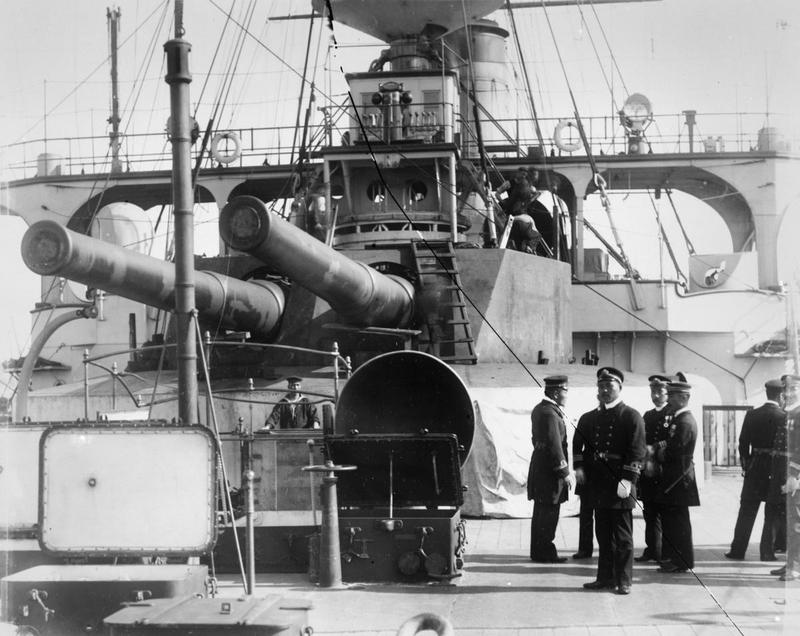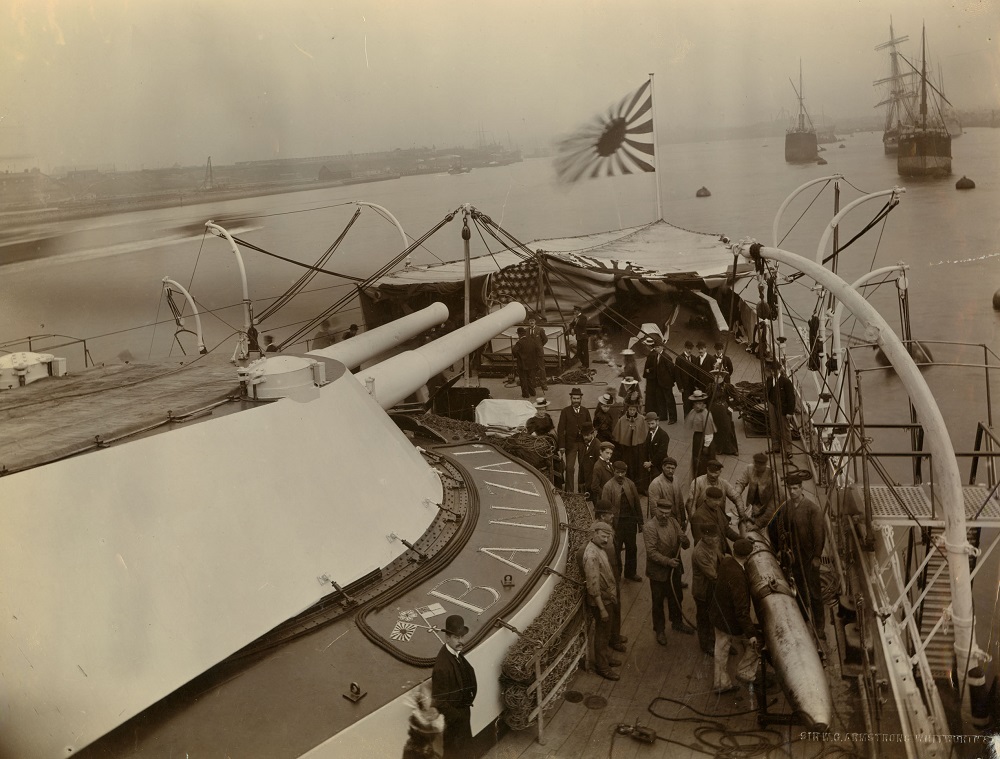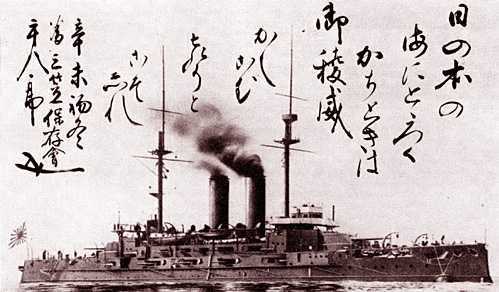
An Elswick/Armstrong design built in Britain to their Patterns G and G1. These guns and mountings were based on current British designs with small changes and were used to arm those Japanese pre-dreanoughts built in Britain.
At the Battle of the Yellow Sea (10 August 1904 Battle or Battle of Shantung) during the Russo-Japanese War, Shikishima lost one gun and Asahi lost both guns in her aft turret due to bore prematures. The problem was traced to faulty fuzes and the new Shimose (picric acid) bursters used in AP projectiles. New fuzes purchased from Krupp were in service prior to the Battle of Tsushima (Battle of the Japan Sea) the following year. According to the report of RN observer Captain Parkenham, these new fuzes were thought to better protect against bore prematures. However, Mikasa and Shikishima each lost one barrel during this later battle due to bore prematures.
The Japanese purchased at least 44 of these guns, which gave them twenty spare barrels.
Mikasa had these guns replaced with the more powerful 12"/45 (30.5 cm) when she was rebuilt following the Russo-Japanese War.
Redesignated as 41st Year Type on 25 December 1908. Redesignated in centimeters on 5 October 1917.
Actual bore length was 40.4 calibers.
| Designation 1 | 12"/40 (30.5 cm) EOC Patterns G and G1
12"/40 (30.5 cm) 41st Year Type (Model 1908) 30 cm/40 (12") 41st Year Type (Model 1908) |
|---|---|
| Ship Class Used On | Fuji, Shikishima and Mikasa Classes |
| Date Of Design | about 1898 |
| Date In Service | 1900 |
| Gun Weight | 49 tons (50 mt) |
| Gun Length oa | N/A |
| Bore Length | about 485 in (12.319 m) |
| Rifling Length | N/A |
| Grooves | N/A |
| Lands | N/A |
| Twist | N/A |
| Chamber Volume | N/A |
| Rate Of Fire | about 1 round per minute |
- ^These ships were all built with EOC guns. Worn guns were replaced mainly with EOC spares, but Fuji in 1910 and Asahi in 1917 were rearmed with Japanese 41st Year Type guns.
- During repairs after being captured by the Japanese, the ex-Russian Poltava now Tango was rearmed with Japanese 12"/40 (30.5 cm) Type 41 guns. Her secondaries were replaced with 6"/45 (15.2 cm) and 3"/40 (7.62 cm) Armstrong guns.
| Type | Bag |
|---|---|
| Projectile Types and Weights | AP - 850 lbs. (386 kg)
Common (HE) - 850 lbs. (386 kg) |
| Bursting Charge 1a | AP (Furoshiki) - 42.5 lbs. (19.3 kg) Shimose
Common (HE) - about 85 lbs. (39 kg) Black Powder |
| Projectile Length | N/A |
| Propellant Charge | 250 lbs. (113.4 kg) Cordite |
| Muzzle Velocity | 2,400 fps (732 mps) |
| Working Pressure | N/A |
| Approximate Barrel Life | N/A |
| Ammunition stowage per gun | Between 115 and 152 rounds |
- ^Bursters for Japanese AP shells were Shimose (picric acid) while Common shells used gunpowder (black powder). As noted above, Shimose of this period was an unstable burster and was prone to bore prematures. Common shells equipped with the new Krupp fuzes were apparently the only projectiles used at the Battle of Tsushima (Battle of the Japan Sea).
- As far as can be determined, Japanese 12-inch (30.5 cm) shells did not penetrate any Russian armor thicker than about 6 inches (15.2 cm) at any of the battles of this war. At the Battle of the Yellow Sea (10 August Battle or Battle of Shantung), the Japanese fired 279 AP of which at least ten hit Russian armor, mainly turrets, and not one penetrated. At Tsushima (Battle of the Japan Sea), the Russian Battleship Orel took a hit on her 5.75-inch (15.8 cm) belt from a 12-inch (30.5 cm) shell which failed to penetrate. The greatest amount of damage to the Russian ships was caused by gunpowder bursters in the Common shells which set large fires in the upper works.
- At the Battle of the Yellow Sea (10 August Battle or Battle of Shantung) the Japanese fired a total of 603 12-inch (30.5 cm) projectiles and made about 30 hits - 4.7%. At Tsushima (Battle of the Japan Sea) the Japanese fired 446 12-in (30.5 cm) projectiles and made about 40 hits - 9%. The increase in hitting was mainly due to the shorter range at the latter battle, fought mainly at a range of 6,500 yards (6,000 m) or less.
| Elevation | Range |
|---|---|
| 15 degrees | about 15,000 yards (13,700 m) |
Barr & Stroud FA3 rangefinders used by the Japanese during the Russo-Japanese war were accurate out to a range of about 8,000 yards (7,300 m).
| Designation | Twin Mount
Fuji (2), Shikishima (2) and Mikasa (2) |
|---|---|
| Weight | about 184 tons (187 mt) |
| Elevation | about -5 / +15 degrees |
| Elevation Rate | N/A |
| Train | About +150 / -150 degrees |
| Train Rate | N/A |
| Gun recoil | N/A |
| Loading Angle | N/A |
- The Fuji class mounts were based upon the British BII mounting used for the 12"/35 (30.5 cm) Mark VIII guns on the Majestic class. The Shikishima class mounts were based upon the British BIV mounting used for the 12"/35 (30.5 cm) Mark VIII guns on the Albion sub-class. The Mikasa mounts were based upon the British BVI mountings used for the 12"/40 (30.5 cm) Mark IX guns used on HMS Formidable.



When Mikasa was decommissioned in 1926, the Mikasa Preservation Association was formed to preserve her as a memorial ship. Admiral Togo was still alive at that time and is believed to be the author of this poem. The association was disbanded at the end of World War II but reformed in 1958. My thanks to Dennis Khong and Eddie Khoo for translating this inscription.

From left to right:
46 cm (18.1") APC, two 12" (30.5 cm) projectiles for Mikasa and a 46 cm (18.1") HE projectile.
Photograph courtesy of Taku Saito and from Museum Trip.
See Pr 13
"Warrior to Dreadnought: Warship Development, 1860-1905" by D.K. Brown
"The Battle of Tsu-Shima" articles in "Warship Volume II" by John Campbell
"Russian Battleship vs. Japanese Battleship: Yellow Sea 1904-05" by Robert Forczyk
"Warships of the Imperial Japanese Navy, 1869-1945" by Hansgeorg Jentschura, Dieter Jung and Peter Mickel
"The Big Gun: Battleship Main Armament 1860-1945" by Peter Hodges
"British Battleships 1860 - 1950" by Oscar Parkes
13 May 2008 - Benchmark
11 May 2009 - Added photograph of Asahi
21 February 2010 - Corrected photograph caption
16 December 2013 - Added photograph of turret
02 December 2015 - Changed Vickers Photographic Archive links to point at Wayback Archive
06 February 2016 - Added ammunition details
02 November 2016 - Converted to HTML 5 format
17 December 2021 - Added photograph of Yashima, reorganized notes
05 February 2022 - Added note about Japanese rearmament of captured Russian ships
25 August 2022 - Fixed note location
29 September 2023 - Fixed broken link to point at Wayback Archive
